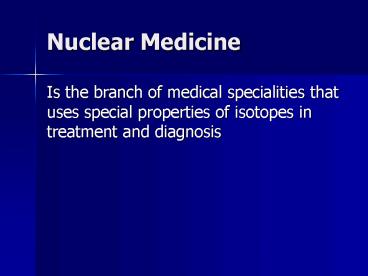Nuclear Medicine - PowerPoint PPT Presentation
1 / 35
Title:
Nuclear Medicine
Description:
Nuclear Medicine Is the branch of medical specialities that uses special properties of isotopes in treatment and diagnosis Example Iodine where atomic No. is 53 while ... – PowerPoint PPT presentation
Number of Views:302
Avg rating:3.0/5.0
Title: Nuclear Medicine
1
Nuclear Medicine
- Is the branch of medical specialities that uses
special properties of isotopes in treatment and
diagnosis
2
Isotopes
- Isotopes of a given element have the same atomic
number but differ in mass numbers.
3
- There are 2450 isotopes of 100 elements
- Unstable isotopes attempt to reach the stability
by emitting energy (radioactivity) - Unstable isotopes ltgt radioactive isotopes ltgt
radioisotopes .
4
Radioactive Decay
- Fission Some heavy nuclei decay by splitting
into 2 or 3 fragments. - Alpha Decay Two protons and two neutrons leave
the nucleus. - Beta Decay - Positron Emission When the number
of protons in a nucleus is in excess, the nucleus
may reach stability by converting a proton into a
neutron with the emission of a beta-plus particle
which is known as a positron.
5
Radioactive Decay
- Positrons annihilate with electrons to produce
two back-to-back gamma-rays. - Gamma Decay A nucleus in an excited state may
reach its ground state by the emission of a
gamma-ray. - A gamma-ray is an electromagnetic photon of high
energy.
6
Radioactive Decay
- Radioactivity is the number of radioactive decays
per unit time. - Half Life The time taken for the number of
radioactive nuclei in the sample to reduce by a
factor of two. - The Unit of radioactivity is the becquerel (Bq)
- 1 Bq one radioactive decay per second.
7
Scintigraphy
- Is a form of diagnostic test where
radioisotopes(Tracers) are given to the patient
internally either intravenously or orally so ,the
Pt. will be the source of radiation. - Then, gamma cameras capture and forms two
dimensional images from gamma rays emitted by the
radioisotopes.
8
Factors Which Affect the Choice of Tracer
- They will concentrate in the organ, or tissue,
which is to be examined. - They will lose their radioactivity (short )
- They emit gamma rays which will be detected
outside the body.
9
Factors Which Affect the Choice of Tracer
- Gamma rays are chosen since alpha and beta
particles would be absorbed by tissues and not be
detected outside the body. - Technitium-99m is most widely used because it has
a half-life of 6 hours.
10
Why is a half-life of 6 hours important?
A half-life of 6 hours is important because
- A shorter half-life would not allow sufficient
measurements or images to be obtained. - A longer half-life would increase the amount of
radiation the body organs or tissues receive.
11
Tracers Used in Nuclear Medicine
Pharmaceutical Source Activity (MBq) Medical Use
Pertechnetate 99mTc 550 - 1200 Brain Imaging
Pyrophosphate 99mTc 400 - 600 Acute Cardiac Infarct Imaging
Diethylene Triamine Pentaacetic Acid (DTPA) 99mTc 20 - 40 Lung Ventilation Imaging
Benzoylmercaptoacetyltriglycerine (MAG3) 99mTc 50 - 400 Renogram Imaging
Methylene Diphosphonate (MDP) 99mTc 350 - 750 Bone Scans
12
Nuclear Medicine Imaging Systems
- Conventional imaging with a gamma camera is
referred to as Planar Imaging, i.e. a 2D image
portraying a 3D object giving superimposed
details and no depth information.
13
The Gamma Camera
-A typical gamma camera is 40 cm in diameter
large enough to examine body tissues or specific
organs. -The gamma rays are given off in all
directions but only the ones which travel towards
the gamma camera will be detected.
-Gamma-cameras can have one, two or three
camera heads..
14
(No Transcript)
15
(No Transcript)
16
DiagnosisStatic Imaging
- -There is a time delay between injecting the
tracer and the build-up of radiation in the
organ. - -Static studies are performed on the brain, bone
or lungs scans.
17
DiagnosisDynamic Imaging
- -The amount of radioactive build-up is measured
over time. - -Dynamic studies are performed on the kidneys and
heart.
18
Single Photon Emission Computed Tomography(SPECT)
- SPECT uses a gamma camera which is rotating
around the patient to acquire slice image. - Modern gamma cameras which are designed for
SPECT scanning consist of two camera heads
mounted parallel to each other with the patient
in between.
19
Example Images
A SPECT slice of a patient's heart.
A series from a SPECT study of a patient's brain.
Images from a SPECT study of a patient's heart.
20
Positron Emission Tomography (PET)
- produces images of slices through the body.
- Positrons are emitted from radioactive nuclei
for stability, positrons do not last for very
long in matter since they will quickly encounter
an electron and a process called annihilation
results.
21
- In this process the positron and electron vanish
and their energy is converted into two gamma-rays
which are emitted at 180o degrees to each other.
The emission is often referred to as two
back-to-back gamma-rays . - If these gamma-rays are detected, their origin
will be detected by a ring of detectors which
encircles the patient and tomographic images can
be generated using a computer system.
22
- The detectors are typically specialised
scintillation devices which are optimised for
detection of these gamma-rays. - This ring of detectors, associated apparatus and
computer system are called a PET Scanner
23
- PET scanner
24
PET/CT
- General Electric Medical Systems
25
- The radioisotopes used for PET scanning are
usually produced using an instrument called a
cyclotron. These isotopes have relatively short
half lives. - PET scanning therefore needs a cyclotron and
associated radiopharmaceutical production
facilities located close by.
26
(No Transcript)
27
(No Transcript)
28
(No Transcript)
29
(No Transcript)
30
(No Transcript)
31
(No Transcript)
32
(No Transcript)
33
(No Transcript)
34
(No Transcript)
35
(No Transcript)































